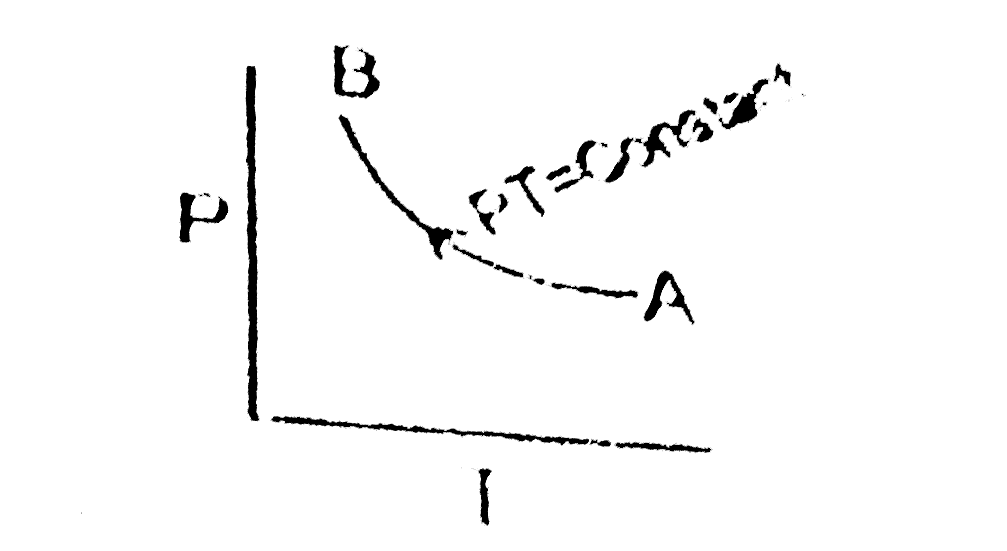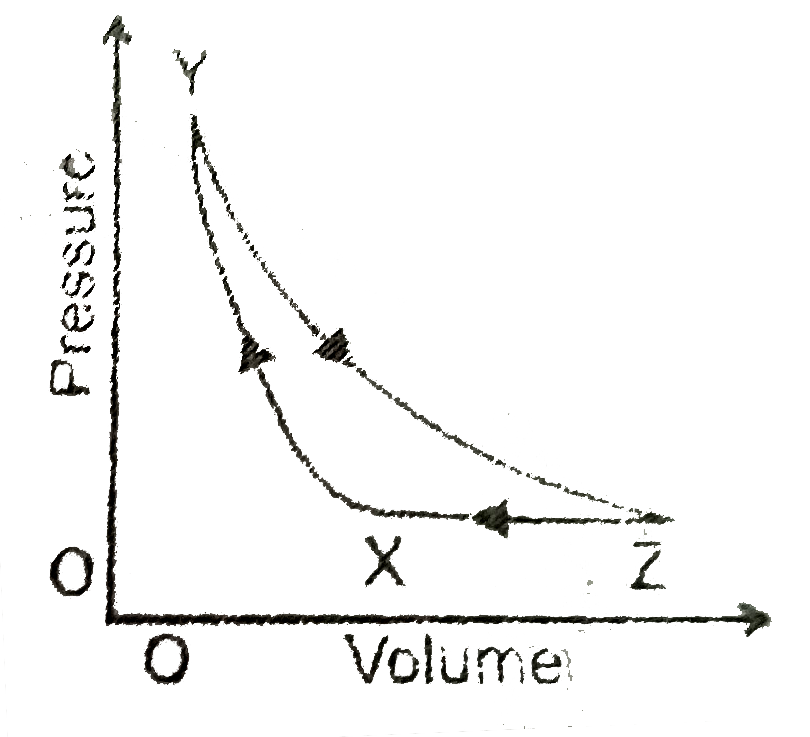A gas undergoes a change at constant temperature. Which of the following quantities remain fixed ?
Pressure
Entropy
Heat exchanged with the system
All the above may change
The correct Answer is:D
To solve the problem, we need to analyze the behavior of a gas undergoing a change at constant temperature. We will use the ideal gas law and the principles of thermodynamics to determine which quantities remain fixed.
1. Understanding the Ideal Gas Law:
The ideal gas law is given by the equation:
PV=nRT
where P is the pressure, V is the volume, n is the number of moles, R is the universal gas constant, and T is the temperature.
2. Constant Temperature Condition:
Since the temperature T is constant, we can denote it as T0. This implies that any changes in volume V will affect the pressure P inversely, according to the equation:
P∝1V
Therefore, if the volume changes, the pressure must also change to maintain the equality.
3. Analyzing Pressure:
From the relationship established, if the volume changes, the pressure cannot remain constant. Thus, pressure P is not fixed.
4. Analyzing Volume:
The volume V is also changing as per the problem statement. Therefore, volume V is not fixed.
5. Work Done:
When a gas expands or compresses at constant temperature, work is done on or by the gas. The work done W is given by:
W≠0
Hence, work done is not fixed.
6. Change in Internal Energy:
The change in internal energy ΔU for an ideal gas depends only on the temperature. Since the temperature is constant, we have:
ΔU=0
Thus, the change in internal energy is fixed at zero.
7. Heat Exchange:
According to the first law of thermodynamics:
Q=W+ΔU
Since ΔU=0, we have:
Q=W
Since work is being done, heat exchange Q is also not fixed.
8. Entropy Change:
The change in entropy ΔS at constant temperature can be expressed as:
ΔS=ΔQT
Since ΔQ is not zero, entropy change S is also not fixed.
Conclusion:
In summary, during a change at constant temperature:
- Pressure P is not fixed.
- Volume V is not fixed.
- Work done W is not fixed.
- Heat exchange Q is not fixed.
- Change in internal energy ΔU is fixed at zero.
- Entropy S is not fixed.
Thus, the only quantity that remains fixed is the change in internal energy, which is zero.
Final Answer:
The only quantity that remains fixed is the change in internal energy ΔU=0.
The ideal gas law is given by the equation:
PV=nRT
where P is the pressure, V is the volume, n is the number of moles, R is the universal gas constant, and T is the temperature.
Since the temperature T is constant, we can denote it as T0. This implies that any changes in volume V will affect the pressure P inversely, according to the equation:
P∝1V
Therefore, if the volume changes, the pressure must also change to maintain the equality.
From the relationship established, if the volume changes, the pressure cannot remain constant. Thus, pressure P is not fixed.
The volume V is also changing as per the problem statement. Therefore, volume V is not fixed.
When a gas expands or compresses at constant temperature, work is done on or by the gas. The work done W is given by:
W≠0
Hence, work done is not fixed.
The change in internal energy ΔU for an ideal gas depends only on the temperature. Since the temperature is constant, we have:
ΔU=0
Thus, the change in internal energy is fixed at zero.
According to the first law of thermodynamics:
Q=W+ΔU
Since ΔU=0, we have:
Q=W
Since work is being done, heat exchange Q is also not fixed.
The change in entropy ΔS at constant temperature can be expressed as:
ΔS=ΔQT
Since ΔQ is not zero, entropy change S is also not fixed.
In summary, during a change at constant temperature:
- Pressure P is not fixed.
- Volume V is not fixed.
- Work done W is not fixed.
- Heat exchange Q is not fixed.
- Change in internal energy ΔU is fixed at zero.
- Entropy S is not fixed.
The only quantity that remains fixed is the change in internal energy ΔU=0.
Topper's Solved these Questions
- THERMODYNAMICSBOOK - AAKASH INSTITUTECHAPTER - THERMODYNAMICSEXERCISE - ASSIGNMENT (SECTION -B) (Objective Type Questions)
23 Videos
- THERMODYNAMICSBOOK - AAKASH INSTITUTECHAPTER - THERMODYNAMICSEXERCISE - ASSIGNMENT (SECTION -C) (Previous Year Questions)
54 Videos
- THERMODYNAMICSBOOK - AAKASH INSTITUTECHAPTER - THERMODYNAMICSEXERCISE - EXERCISE
19 Videos
- THERMAL PROPERTIES OF MATTERBOOK - AAKASH INSTITUTECHAPTER - THERMAL PROPERTIES OF MATTEREXERCISE - Assignment (Section-J) Akash Challengers Questions
7 Videos
- UNITS AND MEASUREMENTSBOOK - AAKASH INSTITUTECHAPTER - UNITS AND MEASUREMENTSEXERCISE - ASSIGNMENT (SECTION - D)
15 Videos
Similar Questions
Knowledge Check
For a fixed mass of a gas at constant temperature which of the following is correct?
APlot of V vs P is linearBPlot of V vs P is non =linear with intercept zeroCPlot of PV vs P is linear with a zero slopeDPlot of PV vs P is linear with positive slopeWhen a body is acted by a constant force, then which of the following quantities remains constant
AVelocityBAccelerationCMomentumDNone of theseFor a satellite in elliptical orbit which of the following quantities does not remain constant ?
AAngular momentumBMomentumCAreal velocityDAll of these
A body is undergoing uniform circular motion then which of the following quantity is constant
View SolutionAn ideal gas undergoing adiabatic change has the following pressure-temperature relationship
View SolutionWhich of the following quantities remain constant during projectile motion?
View SolutionWhen a sample of ideal gas is changed from an initial state to a final state, various curves can be plotted for the process like P-V curve, V-T curve,P-T curve etc.
For example, P-V curve for a fixed amount of an ideal gas at constant temperature is a rectangular hyperbola, V-T curve for a fixed amount of an ideal gas at constant volume is again a straight line. However, the shapes may vary if the constant parameters are also changed.
Now, answer the following questions :
Which of the following statements is correct regarding a fixed amount of ideal gas undergoing the following process :

View SolutionFor a fixed mass of gas at constant volume, which of the following statements is/are (not ) correct ?
View Solution

